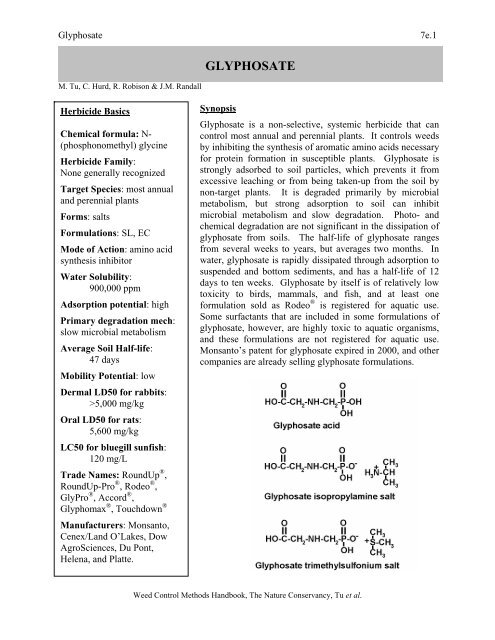Weed Control Methods Handbook: Tools ... - Invasive.org
Weed Control Methods Handbook: Tools ... - Invasive.org
Weed Control Methods Handbook: Tools ... - Invasive.org
You also want an ePaper? Increase the reach of your titles
YUMPU automatically turns print PDFs into web optimized ePapers that Google loves.
Glyphosate 7e.1<br />
M. Tu, C. Hurd, R. Robison & J.M. Randall<br />
GLYPHOSATE<br />
Herbicide Basics<br />
Chemical formula: N-<br />
(phosphonomethyl) glycine<br />
Herbicide Family:<br />
None generally recognized<br />
Target Species: most annual<br />
and perennial plants<br />
Forms: salts<br />
Formulations: SL, EC<br />
Mode of Action: amino acid<br />
synthesis inhibitor<br />
Water Solubility:<br />
900,000 ppm<br />
Adsorption potential: high<br />
Primary degradation mech:<br />
slow microbial metabolism<br />
Average Soil Half-life:<br />
47 days<br />
Mobility Potential: low<br />
Dermal LD50 for rabbits:<br />
>5,000 mg/kg<br />
Oral LD50 for rats:<br />
5,600 mg/kg<br />
LC50 for bluegill sunfish:<br />
120 mg/L<br />
Trade Names: RoundUp ® ,<br />
RoundUp-Pro ® , Rodeo ® ,<br />
GlyPro ® , Accord ® ,<br />
Glyphomax ® , Touchdown ®<br />
Manufacturers: Monsanto,<br />
Cenex/Land O’Lakes, Dow<br />
AgroSciences, Du Pont,<br />
Helena, and Platte.<br />
Synopsis<br />
Glyphosate is a non-selective, systemic herbicide that can<br />
control most annual and perennial plants. It controls weeds<br />
by inhibiting the synthesis of aromatic amino acids necessary<br />
for protein formation in susceptible plants. Glyphosate is<br />
strongly adsorbed to soil particles, which prevents it from<br />
excessive leaching or from being taken-up from the soil by<br />
non-target plants. It is degraded primarily by microbial<br />
metabolism, but strong adsorption to soil can inhibit<br />
microbial metabolism and slow degradation. Photo- and<br />
chemical degradation are not significant in the dissipation of<br />
glyphosate from soils. The half-life of glyphosate ranges<br />
from several weeks to years, but averages two months. In<br />
water, glyphosate is rapidly dissipated through adsorption to<br />
suspended and bottom sediments, and has a half-life of 12<br />
days to ten weeks. Glyphosate by itself is of relatively low<br />
toxicity to birds, mammals, and fish, and at least one<br />
formulation sold as Rodeo ® is registered for aquatic use.<br />
Some surfactants that are included in some formulations of<br />
glyphosate, however, are highly toxic to aquatic <strong>org</strong>anisms,<br />
and these formulations are not registered for aquatic use.<br />
Monsanto’s patent for glyphosate expired in 2000, and other<br />
companies are already selling glyphosate formulations.<br />
<strong>Weed</strong> <strong>Control</strong> <strong>Methods</strong> <strong>Handbook</strong>, The Nature Conservancy, Tu et al.
















